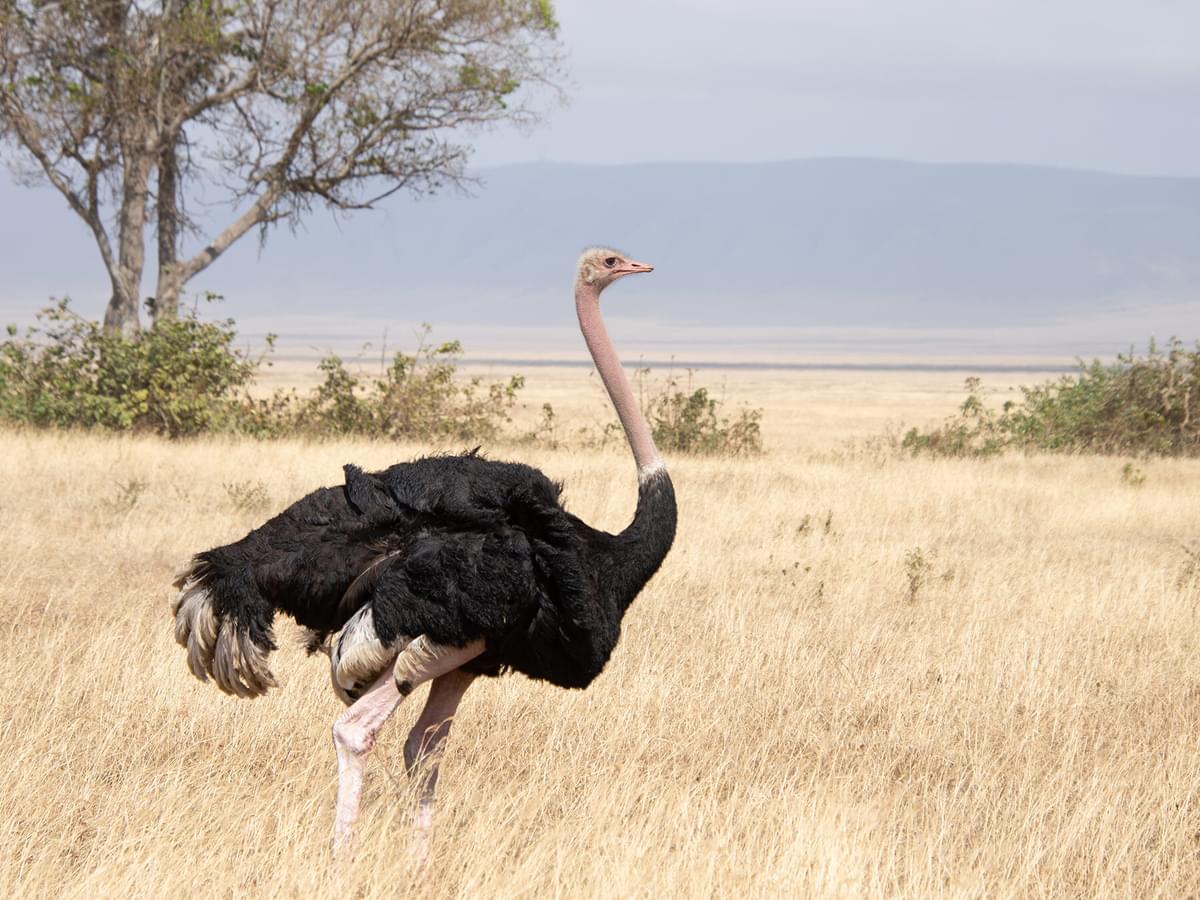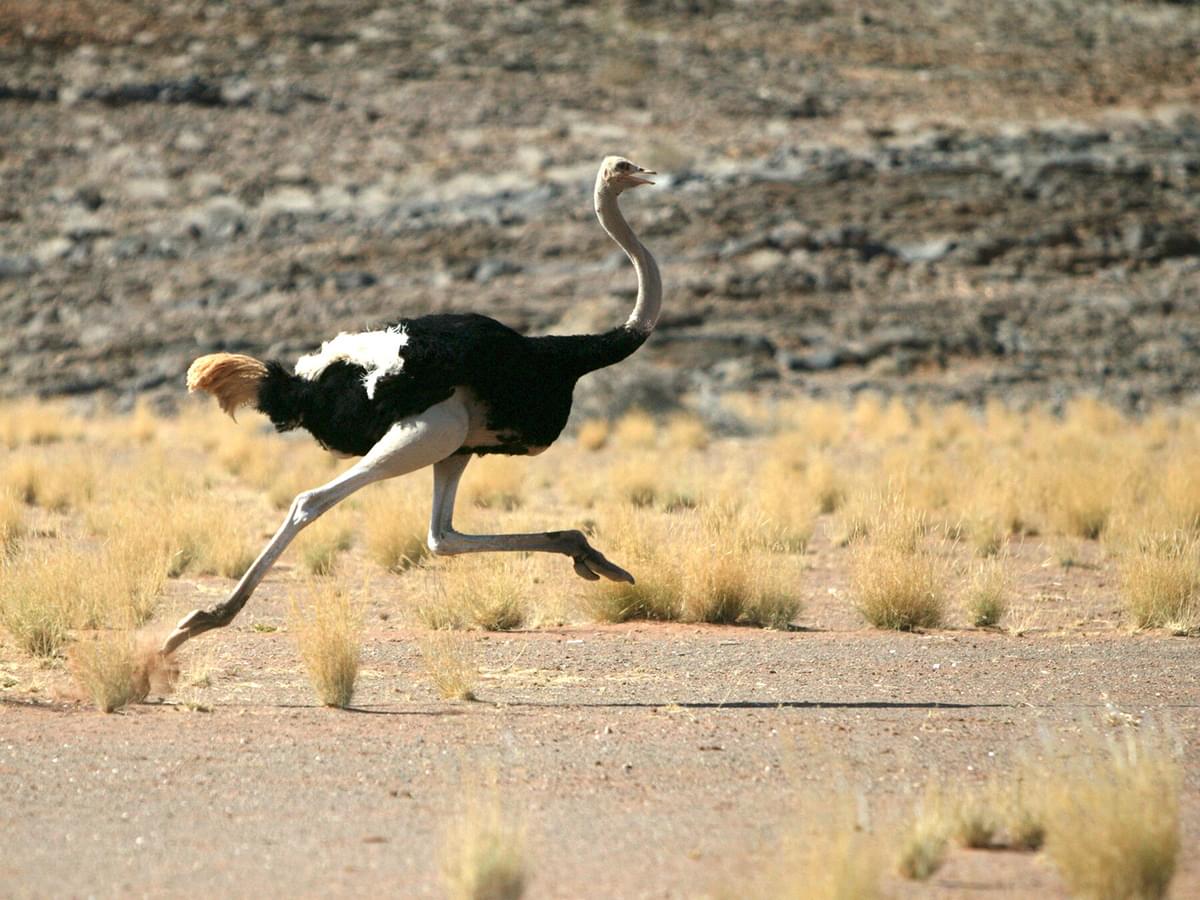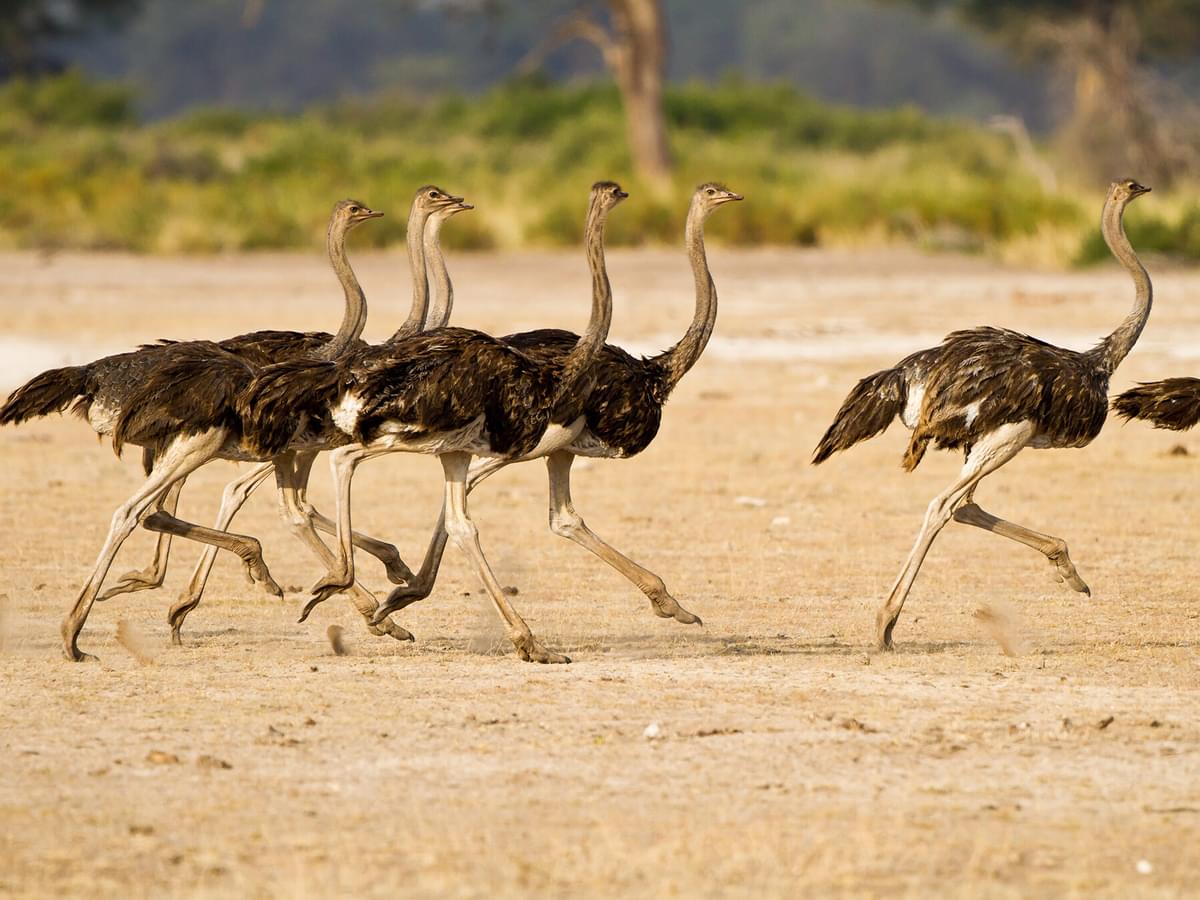Jump to Section
How Fast Can an Ostrich Run? (Everything Explained)
Last updated: 23 January 2023

The Common ostrich is the largest, heaviest bird in the world. These colossal birds can reach a staggering 150kg and 2.8m in height. Ostriches can't fly - they are simply far too large and heavy. To get from A to B, ostriches rely on their powerful legs, but their wings do also have a part to play, despite them being flightless.
So how fast can an ostrich run, and how have they become so adept at running given their enormous size and weight?
Ostriches have a sprint speed of around 40 to 45mph and can cover a huge 5 metres in one single stride. They have been known to approach speeds of 60mph during short bursts, which makes them the fastest terrestrial animal with two legs on the planet.
Ostriches also have tremendous stamina and can maintain speeds of 30mph to 38mph for around half an hour or longer. That means that they can run a 26-mile marathon in approximately 35 to 40 minutes. For comparison, the human marathon record is just over 2 hours.
In addition to their world-record size, weight and speed, ostriches also have the largest eyes of any bird and can see large predators such as lions and hyenas at distances of some 2 miles. In fact, with a diameter of 5cm, their eyes are bigger than their brains!
Read on for more awesome facts about this super-large and rather unique bird.

A common ostrich running in the desert
Is an ostrich the fastest running bird?
There are actually just two species of ostrich in the world; the Common ostrich and the Somali ostrich. The Common ostrich is the biggest, but Somali ostriches aren't far behind.
Both species of ostrich can easily exceed running speeds of 40mph and can cover 5 metres in one single stride. Some ostriches have been measured to reach speeds of some 60mph over very short distances. This comfortably makes the ostrich the fastest running bird in the world. In fact, they are the fastest land running animal on two legs.
How do ostriches run so fast?
Ostriches have three anatomical features that help facilitate their crazy speed and stamina:
- Their enormous, elastic legs with bulky, well-developed upper-leg muscles
- Their perfect centre of gravity
- Their wings stabilise and direct them whilst sprinting
Ostriches have huge legs that are around 40cm to 55cm in length. Their legs contain twice as much elastic energy as human legs, thanks to their large, lengthy and powerful tendons. Ostrich legs are powered by large, well-developed leg muscles that enable the entire length of the leg to swing forward and back at high speeds. Their legs are also thick and robust - one well-placed ostrich kick can kill a lion.
Moreover, ostriches have big, round and balanced bodies, which help them remain stable despite their great height. Their centre of gravity is perfectly tuned for running.
Despite being flightless, ostriches use their large 2m wings to help stay balanced at high speeds, which is essential to ensure that they don't easily fall and injure themselves when running.

A pair of ostriches running on the plain of Amboseli, Kenya
Why do ostriches run fast?
Ostriches are physiologically built for running. Their legs are extremely long with powerful, elastic tendons. Ostrich legs are highly evolved for running, and their centre of gravity ensures stability even at speeds of some 45mph - they're amongst the most capable long distance runners in the animal kingdom.
Since they're so heavy and cannot fly, ostriches needed to evolve powerful legs to outrun predators and move between territories in pursuit of food, water and nesting grounds. Their speed and stamina combined with their excellent sight and tendency to live in groups of 10 to 12 render ostriches highly resilient to predators.
Ostrich's incredible running abilities also enables them to find food and other resources amongst the vast arid Africa plains and savannah. Other birds would simply fly from place to place to find food, water, nesting sites, etc, but since ostriches are too heavy to fly, they adapted to running from A to B instead.
How long can an ostrich run for?
Ostriches can run over long distances without stopping. By sustaining a speed of around 30mph, an ostrich would cover the length of a marathon (26 miles) in around 40 minutes or less.

A male Somali ostrich, walking
How far can an ostrich run in a day?
It's quite hard to estimate how far an ostrich could run in a day. Whilst we know that ostriches are very capable long distance runners, there are few, if any, scenarios where humans would be able to measure how far ostriches can really travel before they reach their limits.
Theoretically speaking, if an ostrich can sustain speeds of 30mph over 1 hour, it could cover some 180 miles in a 12-hour day with one hour's of rest between each 1-hour running period.
Ostriches probably don't run for the sake of it, but only when they need to escape danger or find food and water.
Can all ostriches run fast?
There are two species of ostrich, the Common ostrich and the Somali ostrich. Both are exceptionally fast runners and can reach sprint speeds exceeding 45mph. The Common ostrich is marginally quicker.
Can an ostrich outrun a cheetah?
No terrestrial animal can outrun a cheetah - cheetahs are the fastest land animal on the planet and can reach speeds of 75mph, which is much faster than an ostrich even at maximum speed!
Cheetahs would very rarely target ostriches - ostriches are simply too big and strong and could kill a cheetah in a single kick. There is easier prey at stake than ostriches!

A Cheetah running at full speed
Can an ostrich outrun a lion?
An ostrich will easily outpace a lion over a long distance, but lions have quite similar sprint speeds to ostriches, though they can only sustain them for short periods of time. If the lion was close enough, it could certainly catch out an ostrich with a well-timed attack.
However, ostriches are a far cry from being easy targets for lions or other predators. Given their excellent eyesight combined with their strength, speed and endurance, an ostrich is more-than-capable of fending for itself against one or even multiple lions.
Ostriches tend to live in groups of 10 to 12 ostriches which makes them even harder to attack.
Can a human outrun an ostrich?
Under no circumstance could a human outrun an ostrich. Ostriches can run over twice the speed of an average human. Their top speed of 45mph is comfortably clear of the human sprint world record, which is around 27mph. No human, past or present, can outrun an ostrich - not even over a short distance and certainly not over a long one!

A flock of ostriches running together
What to do if an ostrich chases you?
Ostriches are not overly aggressive unless they need to defend themselves or their young but will certainly attack when startled or provoked. They know their size and strength and aren't afraid to defend themselves - they do live amongst many large and dangerous predators, after all.
The typical advice is to never get too close to an ostrich in the first place. Keep a distance of around 100m. If an ostrich approaches you, move away cautiously. If it gets too close, make yourself small by lying on your front with your head protected. Avoid the kick at all costs.
Can ostriches kill humans?
Ostrich legs are not just good for running; they're also formidable weapons. One ostrich kick can kill an adult lion. There have been human fatalities related to ostrich kicks, but these are rare and usually occur when people provoke wild ostriches.
On this page
- Is an ostrich the fastest running bird?
- How do ostriches run so fast?
- Why do ostriches run fast?
- How long can an ostrich run for?
- How far can an ostrich run in a day?
- Can all ostriches run fast?
- Can an ostrich outrun a cheetah?
- Can an ostrich outrun a lion?
- Can a human outrun an ostrich?
- What to do if an ostrich chases you?
- Can ostriches kill humans?











